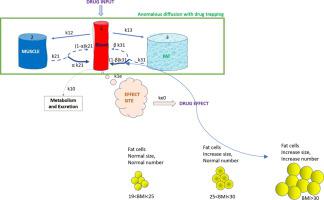Journal of Advanced Research ( IF 11.4 ) Pub Date : 2021-05-21 , DOI: 10.1016/j.jare.2021.04.004 Dana Copot 1 , Clara Ionescu 1, 2

|
Introduction
In long-term induced general anesthesia cases such as those uniquely defined by the ongoing Covid-19 pandemic context, the clearance of hypnotic and analgesic drugs from the body follows anomalous diffusion with afferent drug trapping and escape rates in heterogeneous tissues. Evidence exists that drug molecules have a preference to accumulate in slow acting compartments such as muscle and fat mass volumes. Currently used patient dependent pharmacokinetic models do not take into account anomalous diffusion resulted from heterogeneous drug distribution in the body with time varying clearance rates.
Objectives
This paper proposes a mathematical framework for drug trapping estimation in PK models for estimating optimal drug infusion rates to maintain long-term anesthesia in Covid-19 patients. We also propose a protocol for measuring and calibrating PK models, along with a methodology to minimize blood sample collection.
Methods
We propose a framework enabling calibration of the models during the follow up of Covid-19 patients undergoing anesthesia during their treatment and recovery period in ICU. The proposed model can be easily updated with incoming information from clinical protocols on blood plasma drug concentration profiles. Already available pharmacokinetic and pharmacodynamic models can be then calibrated based on blood plasma concentration measurements.
Results
The proposed calibration methodology allow to minimize risk for potential over-dosing as clearance rates are updated based on direct measurements from the patient.
Conclusions
The proposed methodology will reduce the adverse effects related to over-dosing, which allow further increase of the success rate during the recovery period.
中文翻译:

定制的药代动力学模型来预测长期麻醉中的药物捕获
介绍
在长期诱导的全身麻醉病例中,例如那些由正在进行的 Covid-19 大流行背景唯一定义的病例,催眠药和镇痛药从体内的清除遵循异常扩散,传入药物在异质组织中捕获和逃逸率。有证据表明,药物分子倾向于在缓慢作用的隔室中积聚,例如肌肉和脂肪体积。目前使用的依赖于患者的药代动力学模型没有考虑由于体内药物分布不均而随时间变化清除率引起的异常扩散。
目标
本文提出了 PK 模型中药物捕获估计的数学框架,用于估计最佳药物输注速率,以维持 Covid-19 患者的长期麻醉。我们还提出了一种用于测量和校准 PK 模型的协议,以及一种最大限度减少血液样本收集的方法。
方法
我们提出了一个框架,可以在 ICU 治疗和恢复期间接受麻醉的 Covid-19 患者的随访期间校准模型。所提出的模型可以很容易地使用来自临床协议的关于血浆药物浓度曲线的信息进行更新。然后可以基于血浆浓度测量校准已经可用的药代动力学和药效学模型。
结果
建议的校准方法允许最小化潜在过量给药的风险,因为清除率是根据患者的直接测量值更新的。
结论
拟议的方法将减少与过量给药相关的不利影响,从而进一步提高恢复期间的成功率。











































 京公网安备 11010802027423号
京公网安备 11010802027423号